The butterflies this fall have been utterly delightful. The number of species visiting our garden have been hard to count, but it’s been fun trying. Monarchs, Skippers, Sulphurs, Swallowtails, big, little, striking, camouflaged — you name it, we seem to have it. The Monarchs, always a happy presence, keep skipping off when I bring out the camera, usually because the dogs like to visit the garden when I do. But without a doubt this year the Queen butterflies have put on the biggest show, fluttering about, dancing with each other, visiting all the flowers in the garden, taking a rest, then going at it again.
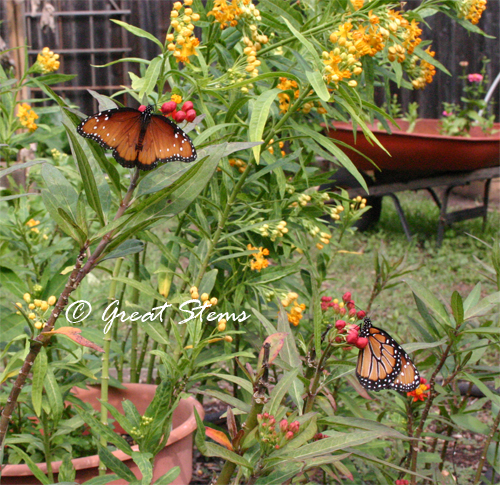
Queens, Monarchs, Viceroys, Soldiers — these butterflies are very often mistaken for one another in the United States, so how does one tell them apart? The fact that they often follow similar regional migration paths certainly doesn’t help.
The Queen butterfly (Danaus eresimus) and its lookalike cousins, the Monarch (Danaus plexippus) and the Soldier (Danaus eresimus) butterflies, are all from the same genus. They enjoy the same larval food, the poisonous Milkweed, which in turn makes all the butterflies unpleasant to predators, and their resemblance to one another helps protect all of them. The fourth lookalike is the Viceroy butterfly (Limenitis archippus), from a different genus. At a quick glance, to me, Soldiers and Queens look very much alike, and Monarchs and Viceroys are most similar to each other. But fortunately there are easy ways to distinguish them all.
But first, butterfly terms. It’s important to know these when identifying or describing features on a butterfly. The four areas typically described are upperside, seen when the wings are opened; underside, or “side view” when the wings are upright; forewings (upper pair); and hindwings (lower pair).
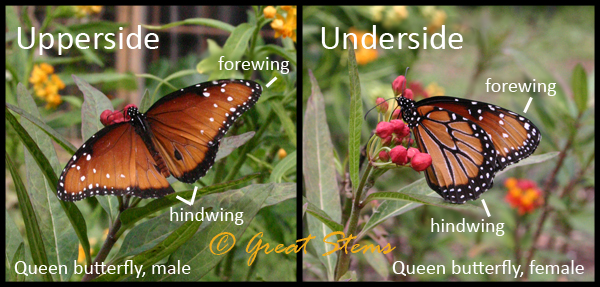 So let’s take a closer look at the Queen butterfly. From the underside, the most noticeable marker is the lack of black veins in the forewing; the Queen’s are pale. The Queen also does not have a series of pale spots along the hindwing found in the similar Soldier butterfly (shown in link farther in post).
So let’s take a closer look at the Queen butterfly. From the underside, the most noticeable marker is the lack of black veins in the forewing; the Queen’s are pale. The Queen also does not have a series of pale spots along the hindwing found in the similar Soldier butterfly (shown in link farther in post).
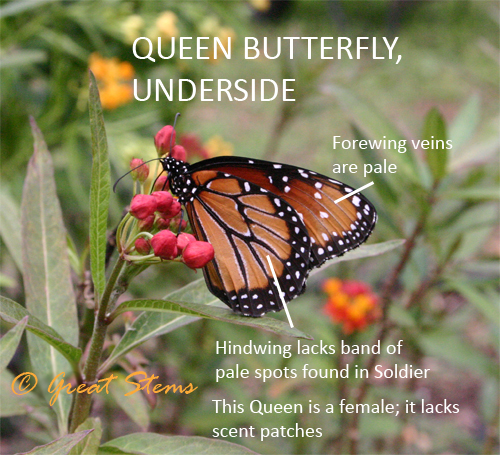
The upperside is also distinctive for the Queen, with its chestnut color and noticeable lack of black veins found in the other species.
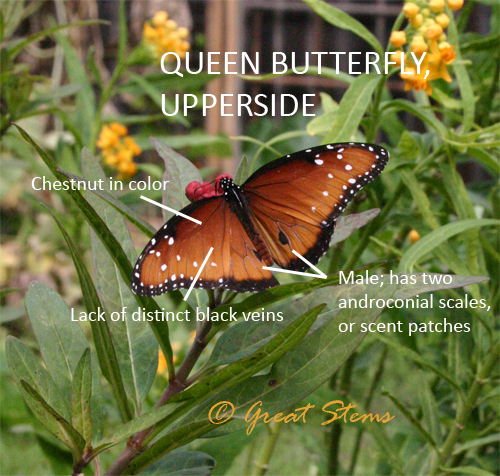
Note in the above two photos that one is a female butterfly and the other is a male. The male Queen butterfly, as in many butterflies, has two scent patches called androconial scales, which distribute the pheromones it uses to attract the females. Here is an underside view of a male Queen.
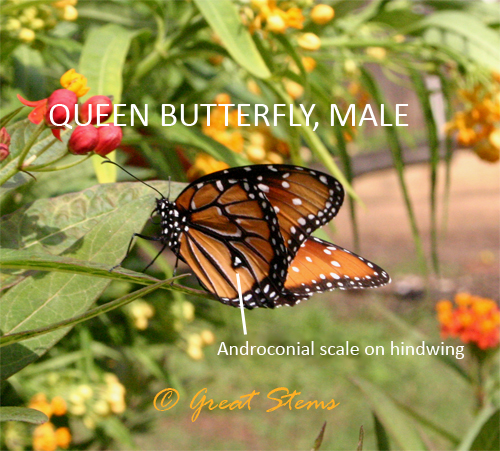 The familiar Monarch butterfly is typically larger and more orange than the Queen butterfly.
The familiar Monarch butterfly is typically larger and more orange than the Queen butterfly.
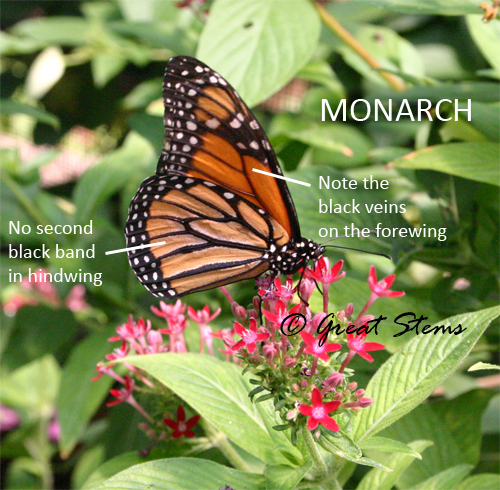 The upperside of a Monarch shows a wide black band along the edge of the forewing. The bold black veins on this Monarch indicate that it is a female; male monarchs have thinner black veins, along with their androconial spots. Monarchs lack a secondary black arc found on the hindwings of Viceroys.
The upperside of a Monarch shows a wide black band along the edge of the forewing. The bold black veins on this Monarch indicate that it is a female; male monarchs have thinner black veins, along with their androconial spots. Monarchs lack a secondary black arc found on the hindwings of Viceroys.
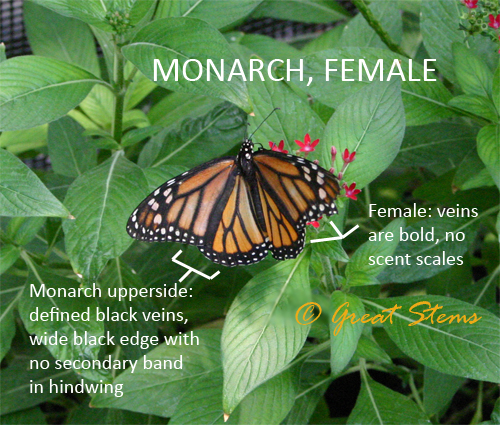
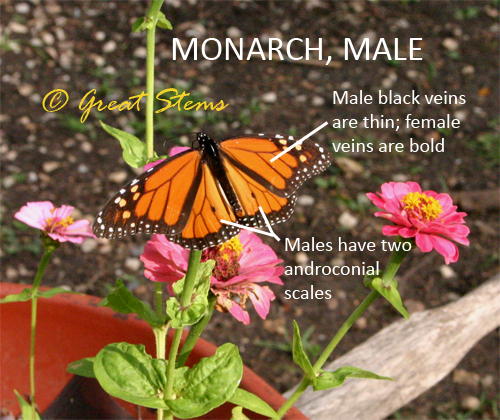 Soldier butterflies are fairly similar to Queens at first glance, but they have black veins on the underside of the forewing and pale spots visible on the underside of the hindwing. The veins of the upperside are also more defined on a Soldier butterfly than on a Queen. Their distribution range is more limited than that of the Queen, typically farther south into Mexico.
Soldier butterflies are fairly similar to Queens at first glance, but they have black veins on the underside of the forewing and pale spots visible on the underside of the hindwing. The veins of the upperside are also more defined on a Soldier butterfly than on a Queen. Their distribution range is more limited than that of the Queen, typically farther south into Mexico.
And finally, the Viceroy. The Viceroy butterfly (Limenitis archippus) is not a member of the same genus as the Monarch, Queen, and Soldier butterflies, but it looks remarkably like them, particular Monarchs. If you click on the link, you’ll see in the picture there that the primary distinguishing mark of a Viceroy is a secondary black line arching through the hindwing on both the upperside and the underside — as mentioned above, Monarchs do not have this.
The Viceroy is an example of Müllerian mimicry because its orange and black markings are like that of whichever Danaus species is local to its area, and all are unpalatable. In this way the four species having similar markings and a bad taste provide them all with added protection from would-be predators.
Did you know that there are other butterflies with similar markings, including one called the Common Tiger in India? It’s a beauty — in addition to the orange and black coloring of Monarchs, the Common Tiger has beautiful white stripes on the forewings. Others are found in Africa and elsewhere in Asia. The animal kingdom sure is fascinating.
I feel like I’ve been to class, and all in the comfort of my own study.
Love all the butterflies and the identification aids. The butterflies are so beautiful whether I know their names or not, but your study makes them even more distinctive.
This is a fantastic tutorial. I always have to go look in my book when the first one shows up. I don’t think I’ve ever seen a Queen here; it’s the Viceroys and Monarchs I have to get out the book for, and all the different Swallowtails for a review.
Nobody ever tells the Sulphurs when winter comes here, so any warm sunny day, they’re out again. Some take refuge in the greenhouse when the door is open.
Thanks, Mary Delle and Nell Jean. I have yet to see a Viceroy or Soldier, but I’m hoping to. I’m glad you like the post — there are other ways to distinguish the four species, but I tried to limit it to what people, including me, are most likely to notice when the butterflies won’t sit still for very long!
Thanks Meredith, that was worth reading.
Wow! What a fantastic lesson and guide to which I can refer back. I love the illustrative photos! Thanks for sharing all this info. Time to get out in the garden with my camera!
I enjoyed learning more about butterfly identification. I have wanted to learn more about them, and your post explained a lot of information very clearly. Thanks!
Thanks Meredith this information is wonderful, a very valuable lesson.
It’s one thing to be able to pass this info along, but to be able to capture it through these great photos as well…
Awesome job!
I had to print this out, so I can take it out to the garden with me.
Seeing how similar they all are, I am not sure if I have ever seen a queen or not. I will certainly be looking.
Thanks for going to the trouble to do this post. I know it was a lot of work. I appreciate it.
Meredith,
I have to go to the dentist today.Uggh. Not my favorite place. You made me forget about it for just a moment while I studied about these butterflies and how to ID them. Thanks for the distraction!
Excellent post, Meredith! Thanks for the info.
I’ve been seeing Queens this week, and I saw a couple of Monarchs two weeks ago. I think both are lovely, but the Queen is an absolute stunner on the upperside.
Oh am I filled with deep envy. Those are such beautiful butterflys. I just love that caramel coloring with milk white polka dots on the male especially. You did a fantastic job detailing out the information for us. This was really a treat for me. Thank you for sharing this.
Oh this is just the right tutorial at just the right time. I adore butterflies, am working on increasing the milkweed numbers (along with other magnet plants) in our yard to lure more in, but I absolutely stink at butterfly ID, sometimes even with a half decent photo on hand. Thanks for this!
Creating tools like these are fun for me — it was my pleasure, and it makes me happy to know the ID guides are useful for others.
thanks so much for that. i have so many butterflies now and the only ones i’m sure of are the gulf frittilaries…:) i really appreciate your identifying the others!
xoxo
I admire your ability to take photos of butterflies. Many have visited the fall flowers in my garden but I can’t manage to get close enough for a decent photo (even using the zoom feature). Do you have any hints or tricks about butterfly photography you can share?
You know, I have the same problem with dragonflies in my garden. They won’t sit still long enough for photos! But I’m finding that butterflies, particularly at this time of year, sit a lot longer for me. My best suggestions are patience, lots of photo snapping, and keep the dogs inside or they’ll scare away the butterflies right when you click the camera! Butterflies also get used to you pretty fast — if you sit nearby, they might fly away for a bit but then come back to the nectar you’re near. We even had a skipper let us touch it, it was so comfortable with us. Or maybe it was ill. But I hope the former!
I am just an observer but we have just witnessed a migration of what first appeared to be moths. But really bigger than moths, and brown. But on closer inspection, 80% brown with orange and white spots. Monarch-like but very little orange. We are in upstate NY by lake Ontario. See a lot of migration but first time with these little things. What are they? Young monarchs? Let me know.
Hi, Steve. Gosh, there are many possibilities. But I do know that they likely wouldn’t be monarchs — butterflies are adults in their full colors as soon as they emerge from the chrysalis. American Snouts have similar colors to what you described (when their wings are open), and they are known for their migration. If you don’t think you have Snouts, I’d love to help you track it down — is there any chance you could send me a picture? meredith(at)greatstems.com Thanks! I love mysteries like this.
Pingback: Humming a Tune in the Garden | Great Stems